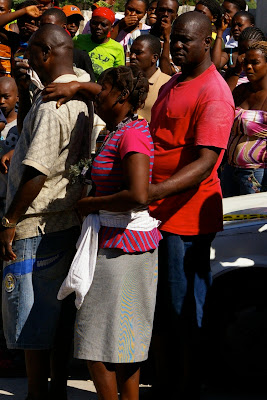Karnaval explained- Episode 3- The Yawe and Fey Bannann
Every year around Karnaval time for the past several years, I have read Edwige Danticat's "After the Dance: A Walk through Carnival in Jacmel, Haiti." Danticat gives great explanations about some of the displays you see during Karnaval and so I thought I'd share some of what she has to say in this post along with some of my pictures.
The Yawe
"The Yawe, (is a) giant mass of cowhide half covered with red satin. On Sunday, as the Yawe strolls down the street... people will come forward, blow loud whistles, and pound on it with sticks... The Yawe sometimes cowering and sometimes attempting to run away, will seem like a blend between a rodeo and a bullfight in which the bull has already been caught but has not quite surrendered."
"According to the journalist Louis Pelissier Baptiste, the thrashing of the Yawe is a re-creation of a huntingscene, a shared memory of the Arawak Indians, the African slaves, and the French buccaneers, in which a whild bull that has already been shot with arrow and wounded is still attempting to run away. How this interactive constume came to be called a Yawe, no one is quite sure. Divers things it might have something to do with Jacmel's 18th century Jewish settlers-- businessmen from the Dutch islands--who may have come up with the display as a reenactment of the sacrifice of a bull to Yahweh, or God."
The Yawe
"The Yawe, (is a) giant mass of cowhide half covered with red satin. On Sunday, as the Yawe strolls down the street... people will come forward, blow loud whistles, and pound on it with sticks... The Yawe sometimes cowering and sometimes attempting to run away, will seem like a blend between a rodeo and a bullfight in which the bull has already been caught but has not quite surrendered."
"According to the journalist Louis Pelissier Baptiste, the thrashing of the Yawe is a re-creation of a huntingscene, a shared memory of the Arawak Indians, the African slaves, and the French buccaneers, in which a whild bull that has already been shot with arrow and wounded is still attempting to run away. How this interactive constume came to be called a Yawe, no one is quite sure. Divers things it might have something to do with Jacmel's 18th century Jewish settlers-- businessmen from the Dutch islands--who may have come up with the display as a reenactment of the sacrifice of a bull to Yahweh, or God."
Fèy Bannan
"Fèy Bannan are people covered from head to tie with dried banana leaves. (According to Divers, the Fèy Bannan disguise was introduced to the Jacmel carnival by children of the bourgeoisie who had traveled to Germany and had come across the straw-clad, bell-ringing figure of Knecht Ruprecht, who during the season of Advent walks through small villages rewarding children who can recite their prayers and punishing those who cannot. Since dried banana leaves were more readily available in Jacmel, they replaced the German straw in the local variation of the costume.)"





Comments
Post a Comment
Hey y'all. Allowing comments now after a long time of not. Please be respectful.